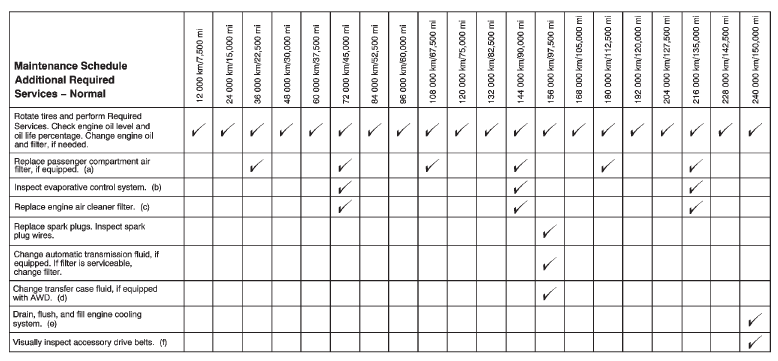 GMC Terrain: Tire Rotation and Required Services Every 12 000 km/ 7,500 mi
GMC Terrain: Tire Rotation and Required Services Every 12 000 km/ 7,500 mi
Rotate the tires, if recommended for the vehicle, and perform the following services. See Tire Rotation on page 10‑57.
○ Check engine oil level and oil life percentage. If needed, change engine oil
and filter, and reset oil life system. See Engine Oil on page 10‑10 and Engine Oil
Life System on page 10‑12.
○ Check engine coolant level. See Engine Coolant on page 10‑17.
○ Check windshield washer fluid level. See Washer Fluid on page 10‑23.
○ Visually inspect windshield wiper blades for wear, cracking, or contamination.
See Exterior Care on page 10‑83. Replace worn or damaged wiper blades. See Wiper
Blade Replacement on page 10‑28.
○ Check tire inflation pressures. See Tire Pressure on page 10‑51.
○ Inspect tire wear. See Tire Inspection on page 10‑57.
○ Visually check for fluid leaks.
○ Inspect engine air cleaner filter. See Engine Air Cleaner/Filter on page 10‑14.
○ Inspect brake system.
○ Visually inspect steering, suspension, and chassis components for damaged, loose,
or missing parts or signs of wear. See Exterior Care on page 10‑83.
○ Check restraint system components. See Safety System Check on page 3‑19.
○ Visually inspect fuel system for damage or leaks.
○ Visually inspect exhaust system and nearby heat shields for loose or damaged parts.
○ Lubricate body components. See Exterior Care on page 10‑83.
○ Check starter switch. See Starter Switch Check on page 10‑27.
○ Check automatic transmission shift lock control function. See Automatic Transmission
Shift Lock Control Function Check on page 10‑27.
○ Check ignition transmission lock. See Ignition Transmission Lock Check on page
10‑28.
○ Check parking brake and automatic transmission park mechanism. See Park Brake
and P (Park) Mechanism Check on page 10‑28.
○ Check accelerator pedal for damage, high effort, or binding. Replace if needed.
○ Visually inspect gas strut for signs of wear, cracks, or other damage. Check the
hold open ability of the strut. See your dealer if service is required. . Inspect
sunroof track and seal, if equipped. See Sunroof on page 2‑20.

Footnotes — Maintenance Schedule Additional Required Services — Normal
a) Or every two years, whichever comes first. More frequent replacement may be needed if the vehicle is driven in areas with heavy traffic, areas with poor air quality, or areas with high dust levels. Replacement may also be needed if there is a reduction in air flow, excessive window fogging, or odors.
b) Check all fuel and vapor lines and hoses for proper hook&-up, routing, and condition. Check that the purge valve, if the vehicle has one, works properly. Replace as needed.
c) Or every four years, whichever comes first.
d) Do not directly power wash the transfer case output seals. High pressure water can overcome the seals and contaminate the transfer case fluid. Contaminated fluid will decrease the life of the transfer case and should be replaced.
e) Or every five years, whichever comes first. See Cooling System on page 10‑15.
f) Or every 10 years, whichever comes first. Inspect for fraying, excessive cracking, or damage; replace, if needed.

Footnotes — Maintenance Schedule Additional Required Services — Severe
a) Or every two years, whichever comes first.
b) Check all fuel and vapor lines and hoses for proper hook&-up, routing, and condition. Check that the purge valve, if the vehicle has one, works properly. Replace as needed.
c) Or every four years, whichever comes first.
d) Do not directly power wash the transfer case output seals. High pressure water can overcome the seals and contaminate the transfer case fluid. Contaminated fluid will decrease the life of the transfer case and should be replaced.
e) Or every five years, whichever comes first. See Cooling System on page 10‑15.
f) Or every 10 years, whichever comes first. Inspect for fraying, excessive cracking, or damage; replace, if needed.
 Engine Oil Change
Engine Oil Change
When the CHANGE ENGINE OIL SOON message displays, have the engine oil and filter
changed within the next 1 000 km/600 mi. If driven under the best conditions, the
engine oil life system might not ...
 Special Application Services
Special Application Services
○ Severe Commercial Use Vehicles Only: Lubricate chassis components every 5 000
km/ 3,000 mi.
○ Have underbody flushing service performed once a year. ...
See also:
Phonebook (phones without automatic phonebook
download function)
“Transfer Entry” A
Use the Transfer Entry command to store a new
name in the system.
When prompted by the system, say the name
you would like to give the new entry.
For example, say: “M ...
Suggestions for economical operation
Your vehicle's fuel economy depends mainly on your style of driving, where you
drive and when you drive. Each of these factors affects how many kilometers (miles)
you can get from liter (a gal ...
Shifting Into Park
WARNING
It can be dangerous to get out of the vehicle if the shift lever is not fully
in P (Park) with the parking brake firmly set. The vehicle can roll. If you have
left the engine running, the ...
